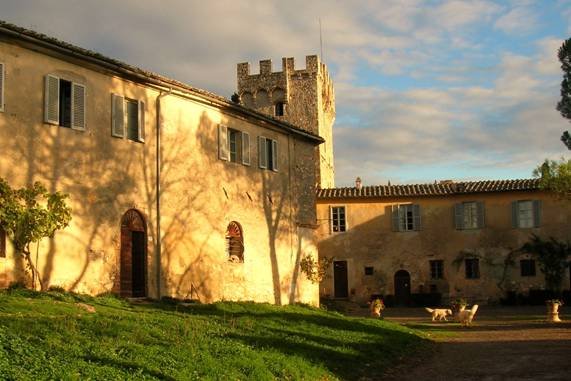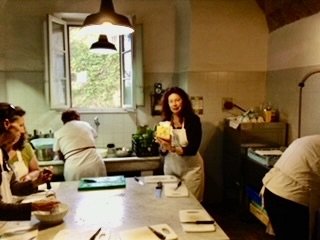Traveling with Cookbooks
Spannocchia, an Italian villa in Tuscany.
In this time when Delta and Omicron Covid variants continue to have us cooking at home rather than eating out, I find myself traveling the culinary world via the pages of cookbooks. Since the pandemic began almost two years ago in March 2020, I’ve become a huge fan of Sam Sifton’s NYTimes.com Cooking column. While reading his suggestions for what to cook while coping with pandemic isolation, I learned about Samin Nosrat’s cookbook Salt, Fat, Acid, Heat and a four-part Netflix documentary inspired by her epicurious travels.
In Nosrat’s article “Cookbooks help me escape these days,” she writes: “Years before I ever set foot in Rome or the Chianti Valley, I traveled there by reading cookbooks….From a handful of single-subject books I still treasure, I spent hours learning about the regional difference in pasta sauces and the individual histories of dozens, if not hundreds of pasta shapes I hoped to one day taste. I grew to love the hot-blooded tradition-protecting Italian culinary sensibility I got to know through these books—so much so that I learned the language and eventually moved to the country.”
At that moment, I traveled back a decade to Spannocchia—an Italian villa in the Tuscan hills with 12th century roots—and the night Kit and I arrived there in the dark. Exhausted after a long journey there, we were immediately led into the dining room where an open wood fire burned warmly, and dinner had been set out in anticipation of our late arrival. Penne pasta, roasted pork, carrots seasoned with the estate’s own extra virgin olive oil and fresh rosemary, hearty Tuscan bread, and bottles of the villa’s own wines.
That night, the we slept the sleep of ages. Roosters reportedly crowed at dawn, but we didn’t hear them. Breakfast alone was our reason to rise and join the other guests for our first cup of dark Italian coffee, toasted Tuscan bread with butter and jam, yogurt and granola drizzled with local honey, hard-boiled eggs with orange yolks and brown shells still warm to the touch, and a huge bowl of fresh apples, oranges, kiwi fruit and grapes.
Returning to our upstairs room across from the villa’s family library, I pushed the tall wooden shutters back and drank in the tranquil landscape beyond an old stone wall bordering the yard below. The low fog of earlier morning had lifted, revealing red-roofed stone farmhouses set in the distant hills, and neatly cultivated fields, olives groves and vineyards set on terraced slopes.
The ankle-deep grass in the yard was flecked with tiny white and yellow wildflowers and an occasional red poppy. Four enormous terra cotta clay pots filled with fruiting lemon trees sunned themselves like happy guests near the limonaia, a former carriage house where the citruses winter over. Tall dark green cypresses stand out like sentry guards against a blue sky billowing with white clouds. A mass of lavender wisteria fans out from a thick woody base across the gray limestone façade of the limonaia.
On a walk that first morning around the grounds, I discovered a fig tree growing from the crevices in a high stonewall, rich with green fruit. Passing through a gated opening into a secluded nook in a nearby woods, I came upon an abandoned stone outbuilding and waded into a sea of knee-deep wildflowers in a shady glade. At its center a rosemary bush wild with purple flowers spilled over the stone rim of the pond covered with algae the gray-green color of bronze oxidized by the ages.
Preparing pasta in Spannocchia’s kitchen.
After spending a morning exploring Spannochia’s vast hillside vegetable garden, I signed up for a cooking class. The tastes of Italy that Samin Nosrat experienced while “traveling” through regional Italian cookbooks, I experienced while making fresh pasta in Spannocchia’s kitchen. I learned about different wheat varieties and special ingredients to countless shapes and fillings, as well as different tools and techniques to make your own pasta at home. Graziella Capanni—a local cook who’d grown up on the estate decades earlier—shared her love of Tuscan cooking and expertise in the kitchen. Following her directions, the class made stuffed spinach ravioli with a brown butter and sage sauce and toasted pine nuts.
In the Spannocchia cookbook I brought home to my kitchen, the introduction begins, “In Italian, we speak of saperi e sapori which translates into knowledge and taste…. By creating traditional dishes, made from products grown on the property, by hands who have created these dishes for decades, we forge a connection to the past and keep knowledge and taste alive.”
Stuffed spinach ravioli prepared in my Nevada City kitchen.
Now when I travel to Italy, it’s through two marvelous cookbooks by my friend Suzanne Dunaway who was my neighbor in Los Angeles lifetimes ago. When I make focaccia bread, it is with Suzanne on the pages of her beautifully illustrated cookbook, No Need to Knead: Homemade Italian Breads in 90 minutes. Or if I make a fresh tomato sauce, I turn to her second cookbook, Rome, at Home. Now that our beautiful granddaughter Catalina has begun a five-month program in Florence studying drawing and Italian language, I will travel with her by sharing recipes prepared in my Nevada City kitchen from my collection of Italian cookbooks.
Suzanne Dunaway preparing focaccia bread.
Feeling the need to escape these days? Be transported to Suzanne Dunaway’s kitchen in Rome via two YouTube demonstrations she’s submitted to The Common Ingredient—a recipe-sharing website started by a small group of women in Columbia, MO in March 2020 in response to the pandemic. We encourage donations to local organizations that help feed those in the community experiencing food insecurity. Share a recipe. Make a donation. Start a chapter of The Common Ingredient in your own community. Be a part of working for a better world.
Visit www.thecommoningredient.com.



